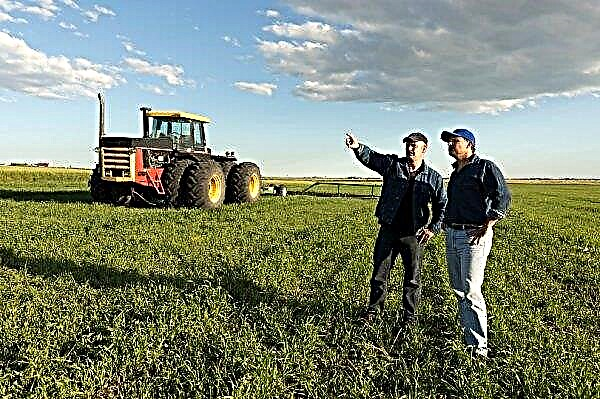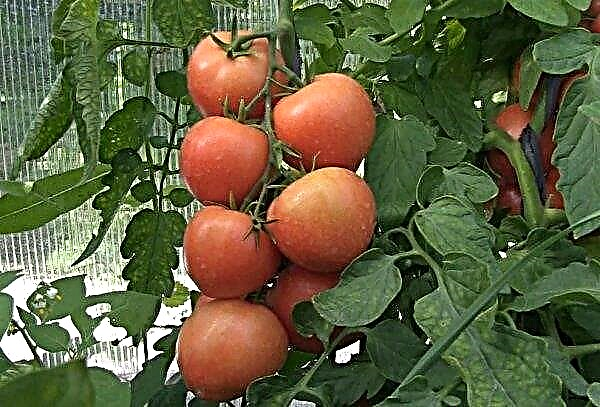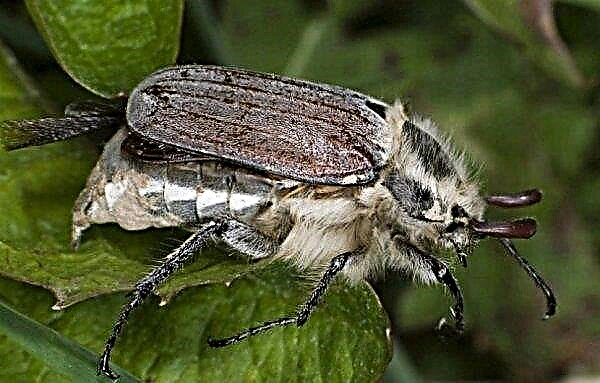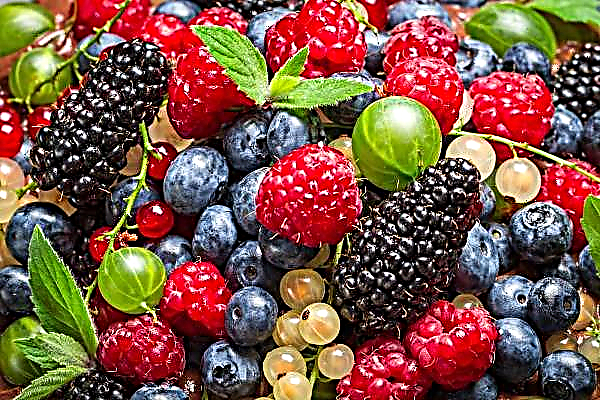Breeders of garden crops do not cease to amaze with the variety of forms, colors and tastes that new hybrids and varieties possess. In this article, we will talk about a new variety of pineapple tomatoes, which attracts not only by its name, but also by its interesting taste.
History and characteristics of the variety
This two-color variety of tomatoes appeared thanks to the efforts of American breeders and was called Bi-color Pineapple Tomato. A feature of this culture can be called its attractive, juicy and bright yellow color on the outside, while the flesh in the middle of the fruit has a more saturated orange color and smoothly turns yellow to the edge. Tomato of this variety has gained popularity due to its interesting taste with sweet notes, which is why it got this name.
Did you know? The yellow color of the pineapple tomatoes indicates that they contain a large amount of vitamin A - a source of carotene, which contributes to good skin condition, removes toxins and improves eyesight.
Gardeners fell in love with the variety for its long fruiting. Pineapple tomatoes are often used fresh for salads and seasonal mixed vegetables. The variety can be processed for the preparation of sauces and adjika, rarely used for preservation, since the fruits are large. Tomatoes are grown in southern regions with a large number of sunny and warm days, in the open ground, and in cooler regions - in high greenhouses.
Botanical Description
The variety is mid-season, indeterminate, ripening within 120-130 days. Bushes reach 1.5–2 m, tall. The formation of the bush occurs in 3 stems. The first inflorescence is formed over 8–9 leaves, each brush of the bush has 5–6 tomatoes. Pineapple fruits are very large, can reach 900 g, but the average weight of tomatoes is 250-300 g. The taste is sweet, with a touch of citrus and fruity notes.
The aroma and palatability of tomatoes improves by the end of the season. The pulp has a dense structure, with a small number of seed chambers. The color of the pulp has two colors: a more saturated orange color in the center of the fruit, changing to a lighter, yellow, to the edges. The variety is resistant to most tomato diseases.
Important! The appearance of the ripe fruit resembles the fruit of the same name, because on the skin of the tomato there are light yellow ribs resembling pineapple flakes.
It should also be said that the following varieties also belong to a series of tomatoes with an unusual pulp color in two or three colors:
- Hawaiian pineapple - large orange fruits with a pronounced pineapple taste, sweet, weighing up to 700 g.
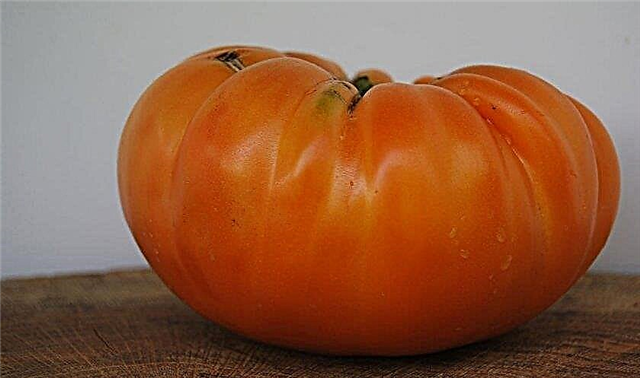
- Golden pineapple - fruits with a yellow cross section with orange stripes have an orange color with pink veins, sweet, the taste is similar to pineapple. The average size of the fruit is 300-400 g, can reach 1 kg.
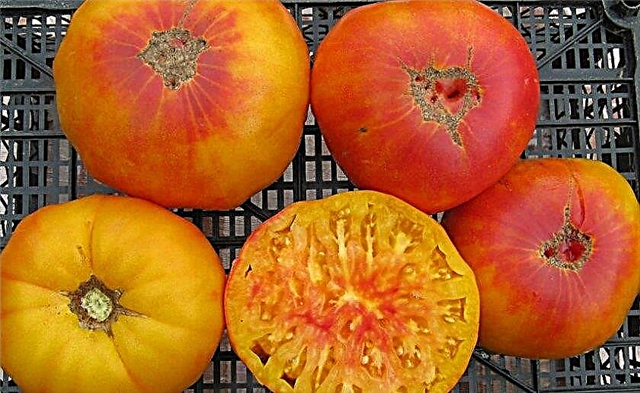
- Black pineapple - a Belgian selection, the fruits have a citrus flavor and a three-color color. Tomatoes are sweet, almost seedless, round and slightly flattened, with ribs, the average weight is 700 g. The color of the tomatoes is always different and can be green, olive, black, yellow, red, orange and burgundy. The tricolor color is also preserved inside the fetus.
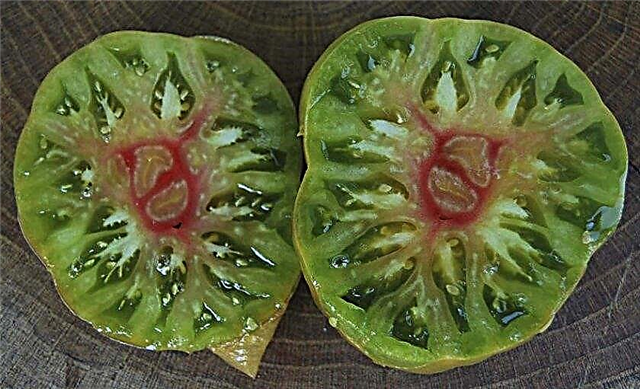
Advantages and disadvantages
- The variety has a large number of positive characteristics, which include:
- early and mid-early ripening;
- prolonged fruiting (in warm regions, the fruiting season can last until September);
- good yield;
- attractive appearance of tomatoes;
- interesting, sweet taste, which becomes more pronounced at the end of the season;
- large fruit size;
- good transportability (does not crack during transportation over long distances);
- does not require much effort in the growing process, unpretentious to conditions;
- can be grown in open ground and high greenhouses;
- It has an attractive presentation.
Pineapple tomatoes are often used on children's and diet menus. Experts and experienced gardeners agree that the variety has practically no negative characteristics. However, tomato bushes require mandatory pinching and garter.
Learn more about other varieties of indeterminate tomatoes:
How to grow tomato seedlings yourself
Planting tomatoes Pineapple is recommended by growing seedlings and then planting them in open ground. In order to independently obtain seedlings, it is necessary to observe the sowing dates, the conditions for preparing and sowing seeds, choose the right substrate for growing, and then create the necessary conditions for germination and seedling growth.
Sowing time
Seeds are recommended to be planted in the prepared soil in early March and no later than the beginning of April.
Soil mix
A home-made substrate in which tomato seeds will be planted should consist of the following components:
- land from the place where in the future it is planned to grow the crop: from a greenhouse or open ground;
- peat;
- washed river sand;
- wood ash.
For growing tomatoes, you can purchase a suitable soil mixture in a specialized store. Before planting seeds, experts recommend cultivating the soil in order to disinfect it and protect seedlings from infection with characteristic diseases, thereby providing good conditions for growing seedlings.
To do this, use a solution of potassium permanganate in a weak concentration. To improve the conditions of seed germination and to obtain faster seedlings, you can treat the soil with growth stimulation preparations.
Capacity for growing
The best solution for growing seedlings are containers. They are filled with suitable soil and seeds are planted in prepared grooves. Subsequently, the seedlings are dived into separate cups.
Seed preparation
The seed preparation process is as follows:
- in order to exclude possible diseases, the seeds are lowered into a weak solution of potassium permanganate;
- To ensure good and fast germination, the seeds are wrapped in wet tissue, cotton wool or gauze soaked with a growth stimulator, and sent to a warm place.
Sowing seeds
In the ground, it is necessary to make grooves with a depth of 1-1.5 cm, in which seeds are placed with a distance of 2 cm.The distance between the grooves should be about 4 cm. After immersion of the seed, it is covered with a thin layer of soil and irrigated from a spray gun.
Seedling Care
After planting seeds, they need to create favorable conditions for rapid germination and good seedling growth.
For this, experts recommend:
- Send the box with seedlings to a warm place with good lighting and cover with glass or plastic wrap.
- The temperature in the room should be within +25 ... + 27 ° C until germination. After the emergence of seedlings, the temperature should decrease slightly and be at the level of +17 ... + 20 ° С.
- Daylight hours for the successful growth of seedlings should be long, about 12 hours a day. If necessary, you can use additional lighting, it is better to use a phytolamp as a lighting device.
- The soil should be moistened as the soil dries, irrigating it with a spray bottle.
- When the seedlings grow up and 2 real leaves appear on it, it is recommended to dive, planting each bush in a separate container. For these purposes it is convenient to use small plastic cups.
- It is recommended to make top dressing in a box with seedlings according to the scheme and manufacturer's recommendations. After picking, it is recommended to introduce fertilizer-rooting agent into the soil along with watering, which will contribute to the good development of the root system. When 5 true leaves are formed on seedlings, the plants are watered with an insecticide solution to protect against pests.

Seedling hardening
The hardening procedure is started a week before the planned moment of planting seedlings in open ground. It is carried out so that young bushes get used to the new growing conditions and better adapt after transplantation.
Seedlings are tempered by exposing glasses with seedlings for several hours to fresh air daily. In this case, direct sunlight should be avoided on a young plant, since it can suffer from this. Gradually, the duration of the "walk" is increased.
Planting seedlings in a permanent place
Seedlings are planted in open ground after gradual hardening and adaptation to growing conditions in the natural environment. Tomatoes Pineapple is not recommended to be planted closely and to thicken the planting, since the bushes are tall.
The timing
Seedlings should be planted in open ground only after the danger of night frost has passed and the soil has warmed enough. Since tomato Pineapple is a mid-season variety, seedlings should not be planted until mid-May, provided that the soil warms up to a temperature of +15 ... + 18 ° С.
Seat selection
A place for growing tomatoes should be well-lit. The arrangement of rows of tomatoes should be such that the bushes are well blown by the wind and moisture does not accumulate, morning dew does not accumulate, which will help protect plants from many diseases. When planting tomatoes, crop rotation should also be considered.
Good predecessors include:
- zucchini;
- carrot;
- cucumbers.
It is not recommended to plant tomatoes after solanaceous:
- potatoes;
- sweet pepper.
Landing pattern
When planting seedlings in open ground, it is necessary to remember that the bushes of the Pineapple variety are tall, so they are planted in accordance with the scheme of 2-3 bushes / 1 m². It is imperative to install a trellis support along which the bush will curl in the future and to which it can be tied.
How to care in the open ground
Pineapple variety is unpretentious in care, however, in order to get a good and tasty crop, some recommendations must be observed.
Watering
The soil should not be too wet to prevent diseases of the root system, so watering should be done as the soil dries, once every 5-7 days. The main thing: to prevent drying of the soil during the setting of tomatoes and their ripening.
Top dressing
When the ovaries begin to appear on the bush and future tomatoes form, the plant necessarily needs additional top dressing. To do this, along with watering under the bush make complex mineral fertilizers.
Important! The introduction of fresh manure should be excluded, since this is a very active fertilizer that can harm young tomato bushes.
Organic feeds can also be used. Regular application of mineral complexes should occur once every two weeks.
Stepson
For indeterminate varieties, the herding procedure is inalienable, since it helps the plant to ensure the effective formation of ovaries and good fruit development. Removing the side shoots accumulates the strength of the bush and it brings a crop with large fruits.
Soil care
Tomatoes love loose soil, so you need to control its condition. To improve soil aeration, regular loosening should be carried out, which will allow the root system to receive more air, which means the plant will develop well. Removing weeds will allow the bushes to receive nutrients from the soil in full.
Tying bushes
Bushes of tomatoes of this variety require the formation of a stem. They can be grown in 1, 2 or 3 stems. The last option is the most optimal. The stem is tied to a support or trellis during the growth process. This allows the plant to fully develop, receive more solar heat and blow well, avoiding the accumulation of moisture.
Since the bush is tall, it is recommended to pinch it at the level of the 14-15th leaf, which will allow the plant to accumulate strength for fruiting.
Preventative treatment
This variety practically does not suffer from diseases typical of tomatoes. However, it is worth remembering that the organization of improper growing conditions, moisture accumulation on foliage, without proper air exchange, as well as increased soil moisture can lead to such diseases:
- gray rot;
- root rot;
- spotted wilting;
- mildew.
In order to prevent diseases, it is recommended to spray the bushes with a solution of soda (250 g per 10 liters of water), and also do not forget about the rules of agricultural culture.
When can I harvest
Fruit harvesting begins when the tomatoes reach the so-called blanche maturity - at this time, the yellow color of the tomatoes becomes saturated, starting to turn into brownish shades. At this point, the taste of tomatoes becomes the brightest.
Did you know? Tomatoes are rich in vitamin C, but its concentration is significantly reduced during their long-term storage.
The yield of the bush can be up to 30 kg of fruits per season, since up to 40 brushes are formed on each plant. The plant begins to bear fruit on average 4 months after the emergence of seedlings and does so until the beginning of autumn in warm regions under cultivation in open ground. Tomatoes are used mainly for fresh consumption, for the preparation of salads. They can be successfully transported without losing their presentation. Pineapple tomatoes have an attractive appearance and unusual taste, their fruits are very large, and the fruiting period of the bushes is long, which makes the variety very popular.
Tomatoes are used mainly for fresh consumption, for the preparation of salads. They can be successfully transported without losing their presentation. Pineapple tomatoes have an attractive appearance and unusual taste, their fruits are very large, and the fruiting period of the bushes is long, which makes the variety very popular.




